BER Reduction and Capacity Enhancement with Novel Guard Sequence Selection for Multi-Carrier Communication
Abstract
1. Introduction
- A new eOFDM block structure with a variable GI sequence for successive blocks of data, which links the selection of the GI sequence based on the data symbols of scattered data subcarriers;
- A versatile block structure that does not need scattered pilot tones in the OFDM block and still provides the option to use a subset of scattered data symbols as pilot subcarriers;
- The detection of the GI sequence improves the detection performance of a subset of data subcarriers, which results in the improved BER performance of the proposed system.
- A unique and flexible block structure, which provides high spectral efficiency as all the subcarriers of the OFDM block are used as data subcarriers.
2. System Model
Proposed eOFDM Block Structure
3. Guard Interval
Generation and Selection of GI
4. Performance Metrics
4.1. Spectral Efficiency
4.2. Energy Efficiency
4.3. Capacity Analysis
5. Numerical Results
6. Conclusions
Author Contributions
Funding
Institutional Review Board Statement
Informed Consent Statement
Data Availability Statement
Acknowledgments
Conflicts of Interest
References
- Conceição, F.; Gomes, M.; Silva, V.; Dinis, R.; Silva, A.; Castanheira, D. A survey of candidate waveforms for beyond 5G systems. Electronics 2020, 10, 21. [Google Scholar] [CrossRef]
- Ayadi, R.; Kammoun, I.; Siala, M. Bridging the Gap Between CP-OFDM and ZP-OFDM for the Provision of Ultra-Low Latency Services in 5G. IEEE Syst. J. 2019, 14, 603–613. [Google Scholar] [CrossRef]
- Maraş, M.; Ayvaz, E.N.; Gömeç, M.; Savaşcıhabeş, A.; Özen, A. A novel GFDM waveform design based on cascaded WHT-LWT transform for the beyond 5G wireless communications. Sensors 2021, 21, 1831. [Google Scholar] [CrossRef]
- Dogra, A.; Jha, R.K.; Jain, S. A survey on beyond 5G network with the advent of 6G: Architecture and emerging technologies. IEEE Access 2020, 9, 67512–67547. [Google Scholar] [CrossRef]
- Rajatheva, N.; Atzeni, I.; Bicais, S.; Bjornson, E.; Bourdoux, A.; Buzzi, S.; D’Andrea, C.; Dore, J.B.; Erkucuk, S.; Fuentes, M.; et al. Scoring the terabit/s goal: Broadband connectivity in 6G. arXiv 2020, arXiv:2008.07220. [Google Scholar]
- Hamamreh, J.M.; Hajar, A.; Abewa, M. Orthogonal frequency division multiplexing with subcarrier power modulation for doubling the spectral efficiency of 6G and beyond networks. Trans. Emerg. Telecommun. Technol. 2020, 31, 3921. [Google Scholar] [CrossRef]
- Liyanaarachchi, S.D.; Riihonen, T.; Barneto, C.B.; Valkama, M. Optimized waveforms for 5G–6G communication with sensing: Theory, simulations and experiments. IEEE Trans. Wirel. Commun. 2021, 20, 8301–8315. [Google Scholar] [CrossRef]
- Van Welden, D.; Steendam, H.; Moeneclaey, M. Iterative decision-directed joint frequency offset and channel estimation for KSP-OFDM. IEEE Trans Commun. 2012, 60, 3103–3110. [Google Scholar] [CrossRef][Green Version]
- Van Welden, D.; Steendam, H. Near optimal iterative channel estimation for KSP-OFDM. IEEE Trans. Signal Process. 2010, 58, 4948–4954. [Google Scholar] [CrossRef]
- Song, J.; Yang, Z.; Yang, L.; Gong, K.; Pan, C.; Wang, J.; Wu, Y. Technical review on Chinese digital terrestrial television broadcasting standard and measurements on some working modes. IEEE Trans. Broadcast. 2007, 53, 1–7. [Google Scholar] [CrossRef]
- Muquet, B.; Wang, Z.; Giannakis, G.B.; De Courville, M.; Duhamel, P. Cyclic prefixing or zero padding for wireless multicarrier transmissions? IEEE Trans. Commun. 2002, 50, 2136–2148. [Google Scholar] [CrossRef]
- Roshandeh, K.P.; Mohammadkarimi, M.; Ardakani, M. Maximum Likelihood Time Synchronization for Zero-Padded OFDM. IEEE Trans. Signal Process. 2020, 69, 641–654. [Google Scholar] [CrossRef]
- Dokhanchi, S.H.; Barreto, A.N.; Fettweis, G. A half-duplex joint communications and sensing system using ZP-OFDM. In Proceedings of the 2022 2nd IEEE International Symposium on Joint Communications & Sensing (JC&S), Seefeld, Austria, 9–10 March 2022; pp. 1–6. [Google Scholar]
- Huemer, M.; Hofbauer, C.; Huber, J.B. The Potential of Unique Words in OFDM. 2010, Volume 10, pp. 140–144. Available online: https://ubdocs.aau.at/open/voll/fodok/inf/AC08250038.pdf (accessed on 21 October 2022).
- Hofbauer, C.; Haselmayr, W.; Bernhard, H.P.; Huemer, M. On the inclusion and utilization of pilot tones in unique word OFDM. IEEE Trans. Signal Process. 2020, 68, 5504–5517. [Google Scholar] [CrossRef]
- Zhang, C.; Song, J.; Wang, J.; Xue, Y.; Pan, C.; Peng, K.; Yang, F.; Wang, J.; Yang, H.; Zhang, Y.; et al. TDS-OFDM based Digital Television Terrestrial Multimedia Broadcasting Standards. SET Int. J. Broadcast. Eng. 2020, 6, 12. [Google Scholar]
- Esmaiel, H. Damped Zero-Pseudorandom Noise OFDM Systems. Int. J. Electron. Telecommun. 2018, 64, 433–438. [Google Scholar]
- Dai, L.; Wang, Z.; Yang, Z. Next-generation digital television terrestrial broadcasting systems: Key technologies and research trends. IEEE Commun. Mag. 2012, 50, 150–158. [Google Scholar] [CrossRef]
- Liu, X.; Qiao, G.; Qing, X.; Zheng, N.; Li, T. Closed-Form Expression for BER of CP-OFDM Systems over an Underwater Acoustic Channel with Statistical Characterization. IEEE Commun. Lett. 2022, 26, 1745–1749. [Google Scholar] [CrossRef]
- Yli-Kaakinen, J.; Loulou, A.; Levanen, T.; Pajukoski, K.; Palin, A.; Renfors, M.; Valkama, M. Frequency-domain signal processing for spectrally-enhanced CP-OFDM waveforms in 5G New Radio. IEEE Trans. Wirel. Commun. 2021, 20, 6867–6883. [Google Scholar] [CrossRef]
- Kim, M.; Kwak, D.Y.; Kim, K.M.; Kim, W.J. Spectral encapsulation of OFDM systems based on orthogonalization for short packet transmission. ETRI J. 2020, 42, 859–871. [Google Scholar] [CrossRef]
- Başaran, M.; Şenol, H.; Erküçük, S.; Çırpan, H.A. Channel estimation for TDS-OFDM systems in rapidly time-varying mobile channels. IEEE Trans. Wirel. Commun. 2018, 17, 8123–8135. [Google Scholar] [CrossRef]
- Song, B.; Gui, L.; Guan, Y.; Zhang, W. On channel estimation and equalization in TDS-OFDM based terrestrial HDTV broadcasting system. IEEE Trans. Consum. Electron. 2005, 51, 790–797. [Google Scholar] [CrossRef]
- Eizmendi, I.; Velez, M.; Gómez-Barquero, D.; Morgade, J.; Baena-Lecuyer, V.; Slimani, M.; Zoellner, J. DVB-T2: The second generation of terrestrial digital video broadcasting system. IEEE Trans. Broadcast. 2014, 60, 258–271. [Google Scholar] [CrossRef]
- Zuo, L.; Wang, J.; Zhao, T.; Cheng, Z. A Joint Low-Rank and Sparse Method for Reference Signal Purification in DTMB-Based Passive Bistatic Radar. Sensors 2021, 21, 3607. [Google Scholar] [CrossRef] [PubMed]
- Hao, J.; Wang, J.; Wu, Y. A new equalizer in doubly selective channels for TDS-OFDM. IEEE Trans. Broadcast. 2015, 61, 91–97. [Google Scholar]
- Steendam, H. Theoretical performance evaluation and optimization of UW-OFDM. IEEE Trans. Commun. 2016, 64, 1739–1750. [Google Scholar] [CrossRef]
- Jaradat, A.M.; Hamamreh, J.M.; Arslan, H. OFDM with subcarrier number modulation. IEEE Wirel. Commun. Lett. 2018, 7, 914–917. [Google Scholar] [CrossRef]
- Zhang, H.; Kong, D.; Xin, Y.; Xiao, L.; Jiang, T. Filter Bank Orthogonal Frequency Division Multiplexing with Index Modulation. IEEE Wirel. Commun. Lett. 2021, 25, 3960–3964. [Google Scholar] [CrossRef]
- Jaradat, A.M.; Hamamreh, J.M.; Arslan, H. OFDM with hybrid number and index modulation. IEEE Access 2020, 8, 55042–55053. [Google Scholar] [CrossRef]
- Proakis, J.G.; Salehi, M. Digital Communications, 4th ed.; McGraw-Hill: New York, NY, USA, 2008; pp. 680–695. [Google Scholar]
- Tufvesson, F.; Edfors, O.; Faulkner, M. Time and frequency synchronization for OFDM using PN-sequence preambles. In Proceedings of the Gateway to 21st Century Communications Village. VTC 1999-Fall. IEEE VTS 50th Vehicular Technology Conference, Amsterdam, The Netherlands, 19–22 September 1999; pp. 2203–2207. [Google Scholar]
- Chung, C.D.; Chen, W.C. Preamble sequence design for spectral compactness and initial synchronization in OFDM. IEEE Trans. Veh. Technol. 2017, 67, 1428–1443. [Google Scholar] [CrossRef]
- Jing, Q.; Cheng, M.; Lu, Y.; Zhong, W.; Yao, H. Pseudo-noise preamble based joint frame and frequency synchronization algorithm in OFDM communication systems. J. Syst. Eng. Electron. 2014, 25, 1–9. [Google Scholar] [CrossRef]
- Chiani, M. Noncoherent frame synchronization. IEEE Trans Commun. 2010, 58, 1536–1545. [Google Scholar] [CrossRef]
- Hsieh, W.H.; Chang, C.F.; Kao, M.S. Efficient acquisition algorithm for long pseudorandom sequence. IEEE Trans. Aerosp. Electron Syst. 2014, 50, 1786–1797. [Google Scholar] [CrossRef]
- Dai, L.; Wang, J.; Wang, Z.; Tsiaflakis, P.; Moonen, M. Spectrum-and energy-efficient OFDM based on simultaneous multi-channel reconstruction. IEEE Trans. Signal Process. 2013, 61, 6047–6059. [Google Scholar] [CrossRef]
- Jeruchim, M.C.; Balaban, P.; Shanmugan, K.S. Simulation of Communication Systems, 2nd ed.; Kluwer Academic/Plenum: New York, NY, USA, 2000. [Google Scholar]

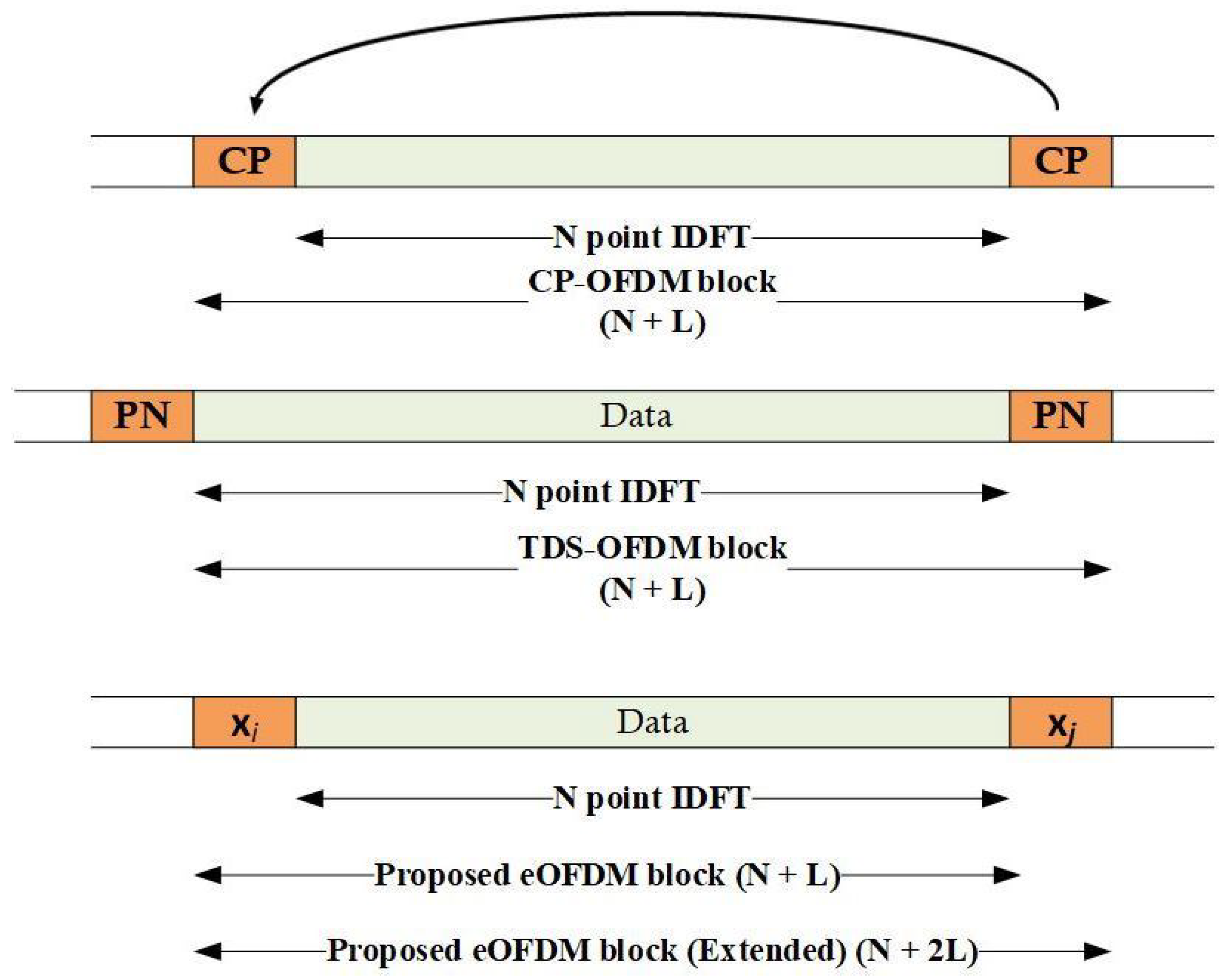
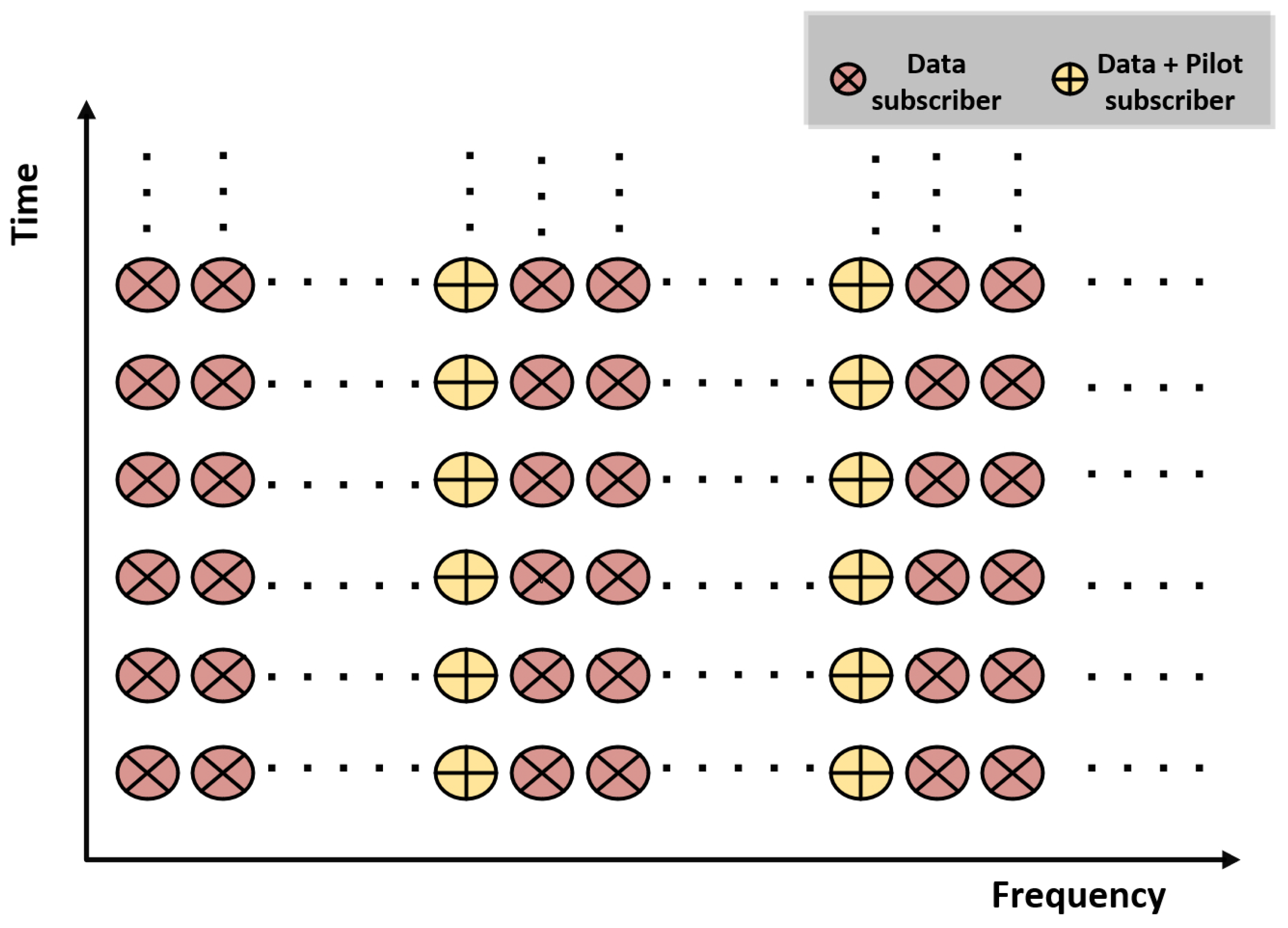
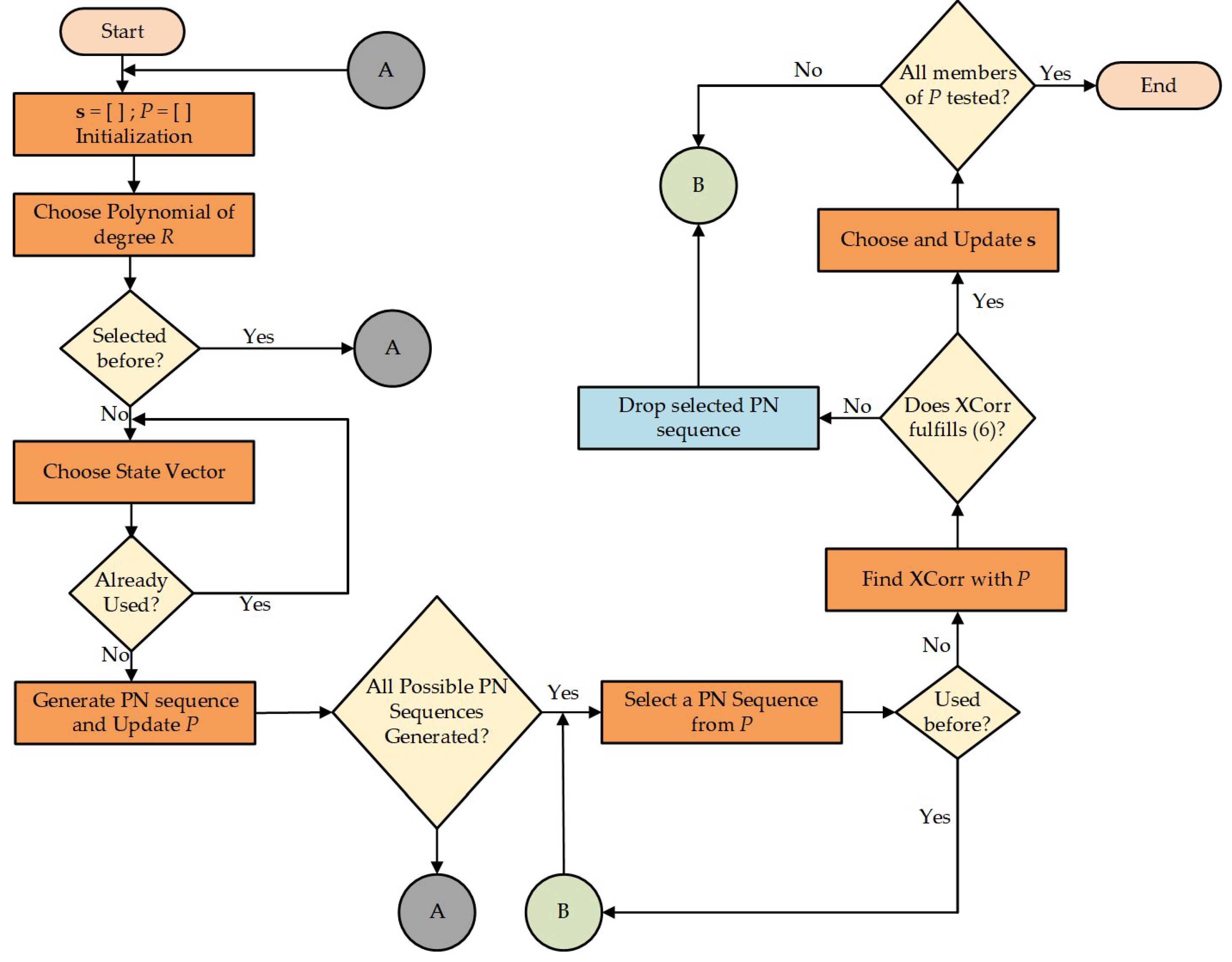
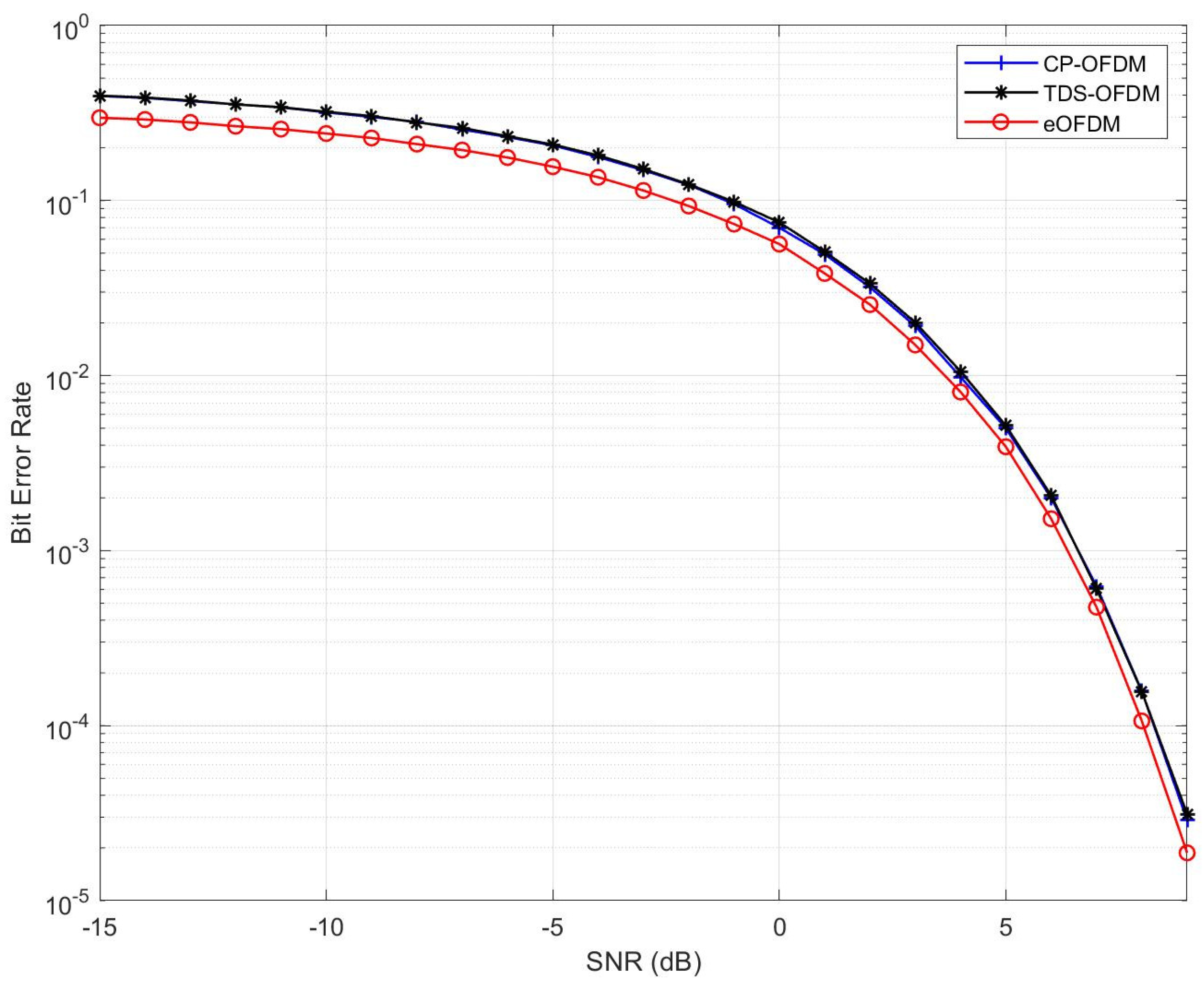
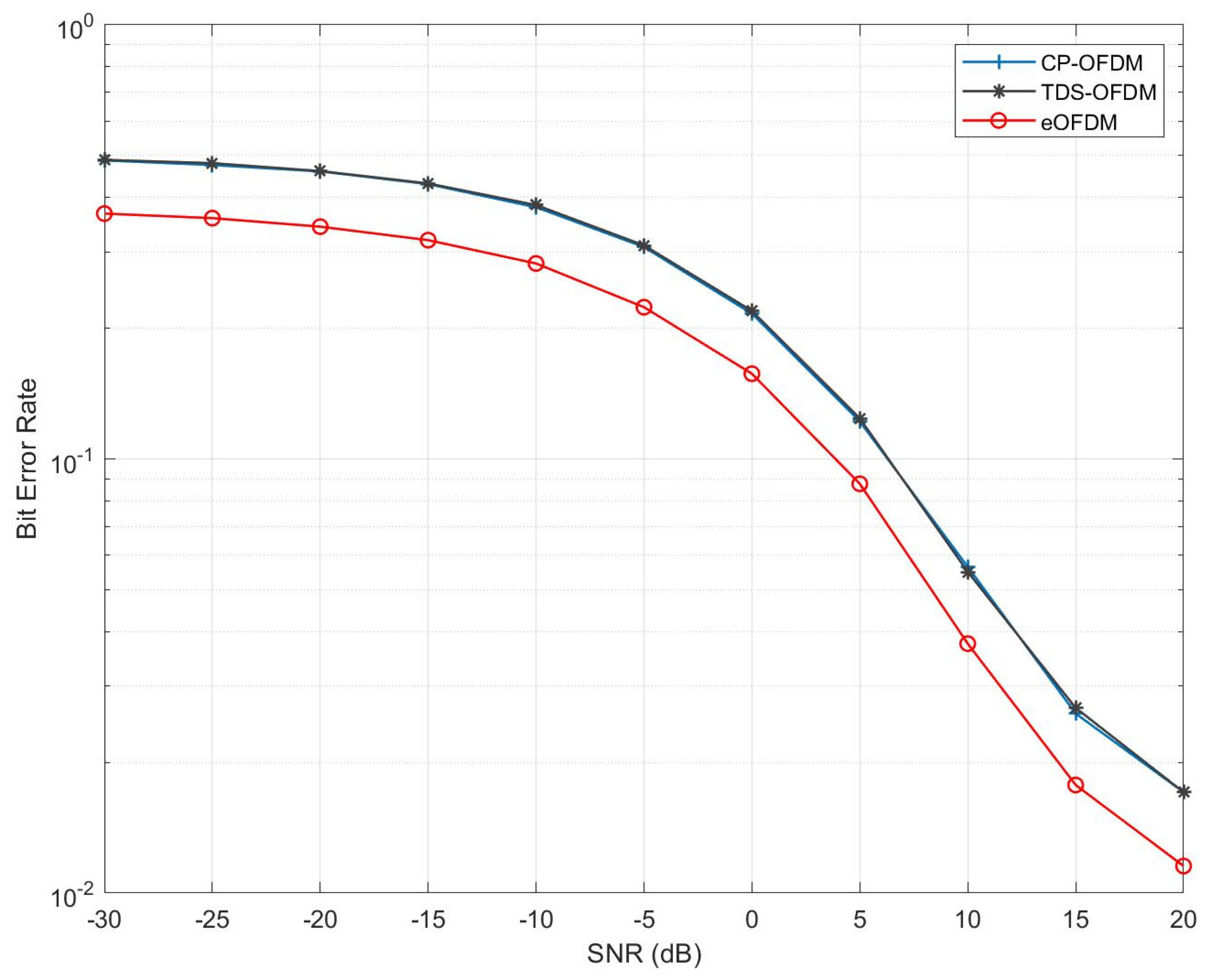
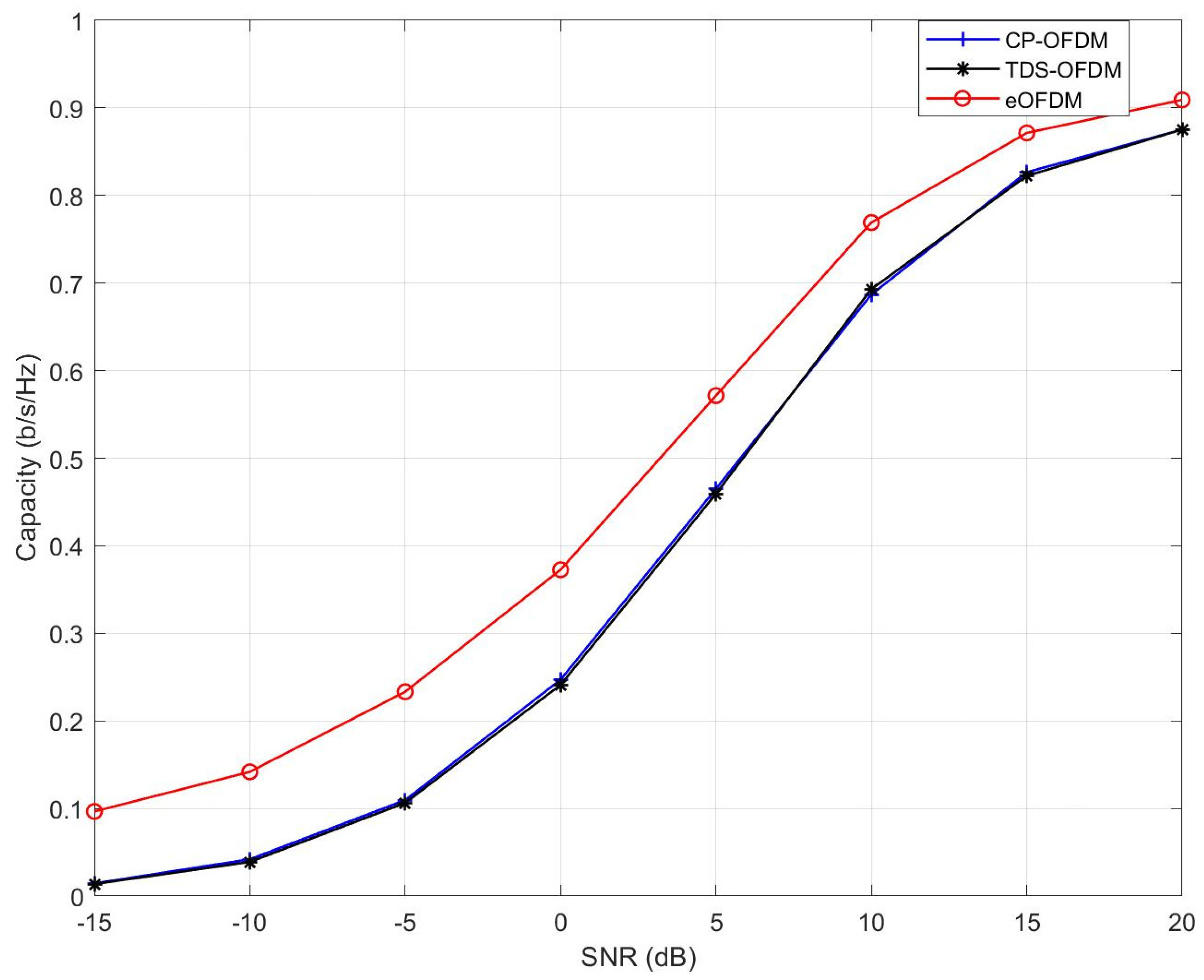
| Guard Interval Significance | Pilot Tones and Flexibility | |
|---|---|---|
| CP-OFDM | Variable CP as GI in each OFDM block is used, which removes ISI | Scattered pilot tones compromises SE; simplified but inflexible block structure |
| TDS-OFDM | Fixed PN sequence as GI in each OFDM block is used, which removes ISI with additional CE capability | No pilot tones, hence no compromise on SE; simplified but inflexible block structure |
| eOFDM | Novel variable PN sequence as GI is used, which removes ISI, improves block BER with additional CE capability | No pilot tones, hence, no compromise on SE, but nevertheless, a subset of data symbols can be used as pilot tones as in CP-OFDM (future extension (FE)) without any compromise on SE; flexible block structure (FE) |
| CP-OFDM | TDS-OFDM | eOFDM | eOFDM | |
|---|---|---|---|---|
| 60% | 80% | 80% | 66.67% | |
| 65.23% | 66.67% | 80% | 66.67% |
| Simulation Parameter | Value |
|---|---|
| Number of channel realizations (h) | 10,000 |
| Path delays (s) | [0, 200, 800, 1200, 2300, 3700] 10 |
| Average path gains (dB) | |
| Doppler frequency | 50 Hz |
| Number of OFDM blocks | 10,000 |
| IDFT/DFT size | 32 |
| Ratio of CP/PN to N | 1/4 |
| Modulation order (M) | 2 |
Disclaimer/Publisher’s Note: The statements, opinions and data contained in all publications are solely those of the individual author(s) and contributor(s) and not of MDPI and/or the editor(s). MDPI and/or the editor(s) disclaim responsibility for any injury to people or property resulting from any ideas, methods, instructions or products referred to in the content. |
© 2022 by the authors. Licensee MDPI, Basel, Switzerland. This article is an open access article distributed under the terms and conditions of the Creative Commons Attribution (CC BY) license (https://creativecommons.org/licenses/by/4.0/).
Share and Cite
Ologun, O.; Wu, S.; Shah, R.A.; Altaf Khattak, S.B.; Nasralla, M.M. BER Reduction and Capacity Enhancement with Novel Guard Sequence Selection for Multi-Carrier Communication. Sensors 2023, 23, 217. https://doi.org/10.3390/s23010217
Ologun O, Wu S, Shah RA, Altaf Khattak SB, Nasralla MM. BER Reduction and Capacity Enhancement with Novel Guard Sequence Selection for Multi-Carrier Communication. Sensors. 2023; 23(1):217. https://doi.org/10.3390/s23010217
Chicago/Turabian StyleOlogun, Oluwaseun, Shaochuan Wu, Raza Ali Shah, Sohaib Bin Altaf Khattak, and Moustafa M. Nasralla. 2023. "BER Reduction and Capacity Enhancement with Novel Guard Sequence Selection for Multi-Carrier Communication" Sensors 23, no. 1: 217. https://doi.org/10.3390/s23010217
APA StyleOlogun, O., Wu, S., Shah, R. A., Altaf Khattak, S. B., & Nasralla, M. M. (2023). BER Reduction and Capacity Enhancement with Novel Guard Sequence Selection for Multi-Carrier Communication. Sensors, 23(1), 217. https://doi.org/10.3390/s23010217







